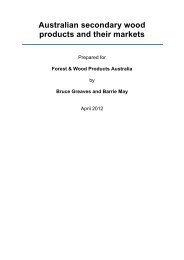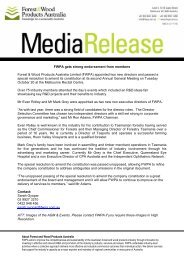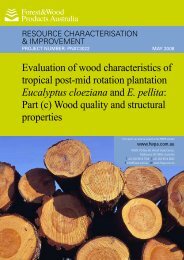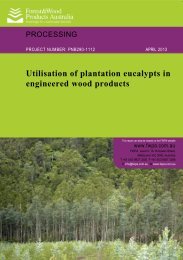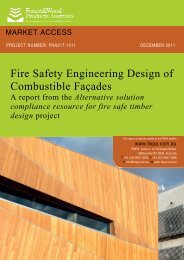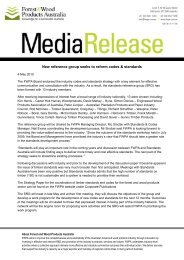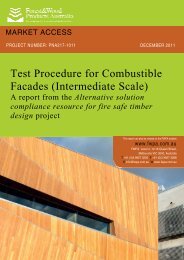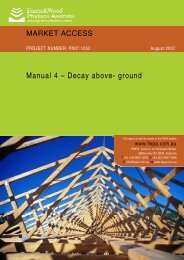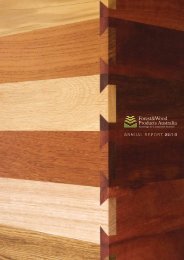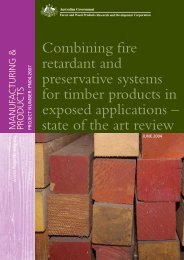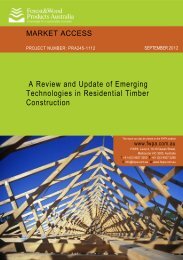Predicting the water-use of Eucalyptus nitens plantations in ...
Predicting the water-use of Eucalyptus nitens plantations in ...
Predicting the water-use of Eucalyptus nitens plantations in ...
You also want an ePaper? Increase the reach of your titles
YUMPU automatically turns print PDFs into web optimized ePapers that Google loves.
1. Introduction<br />
Plantation development can result <strong>in</strong> changes to <strong>the</strong> availability <strong>of</strong> <strong>water</strong> (ei<strong>the</strong>r as streamflow<br />
or <strong>in</strong> ground<strong>water</strong>). Where grassland is planted with trees, <strong>water</strong> availability can decrease<br />
(Bosch and Hewlett, 1982: Vertessy, 2001: Bren et al., 2006: Best et al, 2003). Where forest<br />
is replaced with plantation <strong>the</strong>re can be changes <strong>in</strong> <strong>water</strong> availability <strong>in</strong> ei<strong>the</strong>r direction (Bren<br />
and Hopmans, 2007: Bren et al., 2006: Cornish and Vertessy, 2001). The changes <strong>in</strong> <strong>water</strong><br />
availability are l<strong>in</strong>ked to changes <strong>in</strong> <strong>the</strong> capacity <strong>of</strong> vegetation to <strong>use</strong> <strong>water</strong>.<br />
In this paper, <strong>water</strong>-<strong>use</strong> is <strong>the</strong> term <strong>use</strong>d to describe <strong>the</strong> total amount <strong>of</strong> <strong>water</strong> evaporated<br />
from an area <strong>of</strong> plantation due to transpiration, canopy <strong>in</strong>terception and soil evaporation.<br />
However, it is common for o<strong>the</strong>r authors to <strong>use</strong> <strong>the</strong> terms evapotranspiration or <strong>in</strong>terception<br />
to describe <strong>water</strong>-<strong>use</strong>. Water availability is <strong>the</strong> term <strong>use</strong>d <strong>in</strong> this paper to describe <strong>the</strong><br />
difference between ra<strong>in</strong>fall and <strong>water</strong>-<strong>use</strong>. Available <strong>water</strong> ei<strong>the</strong>r becomes streamflow, or<br />
moves <strong>in</strong>to and through soil or aquifers. O<strong>the</strong>r authors may refer to <strong>water</strong> availability as<br />
<strong>water</strong> yield or describe its components.<br />
In regions <strong>of</strong> Australia where <strong>water</strong> resources are <strong>in</strong> limited supply or where <strong>the</strong>re is concern<br />
that aquatic, riparian or ground<strong>water</strong> ecosystems could be impacted by reduced <strong>water</strong><br />
availability, <strong>water</strong> licens<strong>in</strong>g, codes <strong>of</strong> practice, regulations and policy have been developed to<br />
preserve <strong>water</strong> resources. These codes and regulations may limit plantation development or<br />
make it more expensive.<br />
The National Water Initiative represents an agreement by governments across Australia to<br />
achieve a more cohesive approach to <strong>the</strong> way Australia manages, measures, plans for, prices,<br />
and trades <strong>water</strong> (Council <strong>of</strong> Australian Governments, 2005). The National Water Initiative<br />
gives governments <strong>the</strong> power to manage <strong>in</strong>terception by <strong>plantations</strong> ei<strong>the</strong>r by limit<strong>in</strong>g <strong>the</strong>ir<br />
development or by issu<strong>in</strong>g <strong>water</strong> licences.<br />
In South Australia, <strong>the</strong> State government has policies to limit plantation development <strong>in</strong> some<br />
locations or to issue <strong>water</strong> licences to protect ground<strong>water</strong> resources (Department for Water,<br />
2012). In some states, Forestry regulators and Codes <strong>of</strong> Forest Practice limit <strong>the</strong> extent <strong>of</strong><br />
forest and plantation activity <strong>in</strong> some catchments. For example, catchments contribut<strong>in</strong>g to<br />
council or domestic <strong>water</strong> supplies, or catchments with threatened aquatic species, may have<br />
limits on <strong>the</strong> area <strong>of</strong> plantation developed dur<strong>in</strong>g a nom<strong>in</strong>ated period (Forest Practices Board,<br />
2000).<br />
In rare cases, plantation development has been prevented by legal action from neighbours<br />
who fear that local surface and ground<strong>water</strong> resources would be compromised by plantation<br />
development (e.g. Forest Practices Tribunal, 2009 - Clement v FPA and Curran, 2009).<br />
Restrictions on plantation development or a requirement to purchase <strong>water</strong> licences<br />
ultimately lead to greater costs for <strong>in</strong>dustry through greater dispersion <strong>of</strong> <strong>the</strong> plantation estate<br />
or through <strong>the</strong> purchase <strong>of</strong> <strong>water</strong> licences.<br />
1



